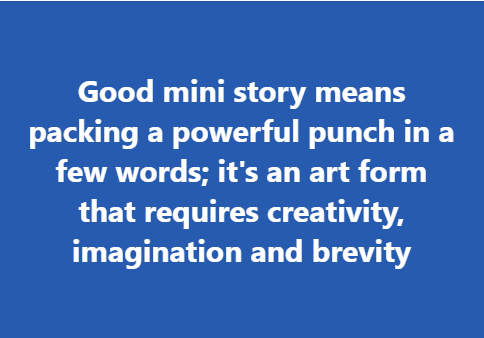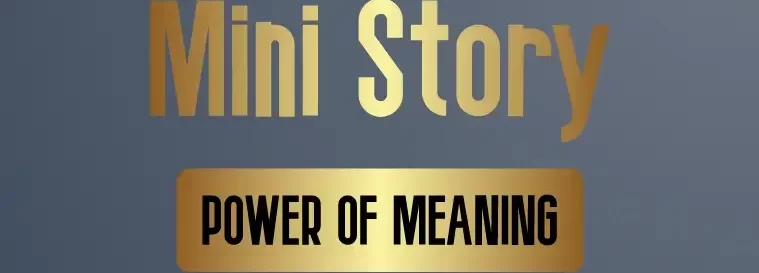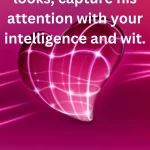“The wisdom gained from a mini story is profound; it often carries more meaning than expected.”
Table of Contents
Mini stories are a powerful tool used by copywriters and marketers to capture the attention of their audience. These short, impactful narratives are designed to create an emotional connection with the reader, leaving a lasting impression that can influence their decision-making process.
At its core, a mini story is a condensed version of a larger narrative. It follows the same structure as any good story, with a beginning, middle, and end. However, what sets mini stories apart is their brevity and focus on delivering maximum impact in minimal words. In this article, we will explore what mini stories are and why they are such an effective marketing technique.
Defining mini story in context
A mini story is a short narrative that conveys a message or emotion in just a few sentences. It’s also known as a micro-story or flash fiction. A good mini story should have the same elements as any other story: it needs to have characters, setting, conflict, and resolution. However, due to its brevity, every word counts.
One of the benefits of writing mini-stories is that they can be used for various purposes. They are perfect for social media platforms where attention spans are minimal; they can help you get your point across quickly and effectively. They can also be used as writing prompts to practice storytelling skills or even to spark inspiration for longer stories.
In conclusion, although mini stories are brief narratives, they hold immense power in delivering messages and emotions in an impactful way. As such, mastering the art of crafting them is vital for effective communication in today’s fast-paced world.

History:
Mini stories are a form of creative writing that convey a complete narrative in just a few sentences. They are often used as writing exercises to help writers practice their storytelling skills and develop their ability to create engaging characters, settings, and plots. Mini stories can be written on any topic, from personal experiences to fictional tales.
When it comes to history, mini stories can be an effective way to bring the past alive for readers. By focusing on a particular event or moment in time, writers can craft a mini story that captures the essence of what happened and helps readers connect with the people and events of the past.
Some examples of historical mini stories include brief accounts of famous battles, important speeches, or significant moments in the lives of historical figures.
For historians and writers interested in exploring history through mini-stories, there is no shortage of material to draw from. From ancient civilizations to modern-day events, every era has its own unique stories waiting to be told in miniature form.
Whether you’re looking for inspiration or simply want to hone your writing skills, exploring history through mini-stories can be an exciting and rewarding experience.
Origins and evolution of mini story
A mini story is a brief narrative that conveys a complete plot and message in a concise manner. This form of storytelling has become increasingly popular in recent years due to its ability to capture the reader’s attention quickly and efficiently.
While the origins of mini stories are difficult to trace, it is believed that they have been used as a teaching tool for centuries.
In the 20th century, mini stories saw an increase in popularity thanks to authors such as Ernest Hemingway and O. Henry, who championed the art of brevity in their writing. Hemingway’s famous six-word story, “For sale: baby shoes, never worn,” is often cited as an example of how much can be conveyed with just a few words.
With the rise of social media platforms like Twitter and Instagram, where character limits abound, mini stories have become even more prevalent.
Today, mini stories can be found not only in literature but also in advertising campaigns and brand messaging. Their succinct nature makes them ideal for capturing attention and leaving a lasting impression on audiences with limited time or attention spans. As technology continues to shape our communication habits, it’s likely that the use of mini stories will only continue to grow.
Elements:
A mini story is a short, engaging narrative that can be used in copywriting to grab the reader’s attention and create an emotional connection. There are several elements that make up a successful mini story, including characters, conflict, resolution, and emotion.
Characters are essential because they give the reader someone to relate to and care about. The protagonist of the story should have clear goals and motivations that drive their actions throughout the narrative.
Conflict is also crucial as it creates tension and keeps the reader engaged. Whether it’s a personal struggle or an external obstacle, conflict adds drama to the story.
The resolution of a mini story should provide closure for both the character and the reader. Ideally, it will leave them feeling satisfied with how things turned out while also reinforcing any messaging or branding goals of the copywriting piece. Finally, emotion is key as it helps readers connect with both the character and your brand on a deeper level.
By using sensory details and evocative language throughout your mini story, you can create an emotional experience that resonates with your audience long after they’ve finished reading.
Components of a compelling mini story
A mini story is a short, engaging narrative that captures the essence of an idea or message. It is a powerful tool for copywriters to grab the reader’s attention and create an emotional connection with them. To craft a compelling mini story, it is essential to have certain components in place.
Firstly, the protagonist of the story should be relatable and likeable. The reader should be able to identify with their struggles and empathize with their journey.
Secondly, there should be a clear conflict or challenge that the protagonist faces, which creates tension and keeps the reader engaged. This conflict should also reflect the problem that your product or service solves.
Thirdly, there needs to be a resolution or transformation at the end of the story. This can either come in the form of overcoming adversity or achieving success after using your product/service.
Finally, adding sensory details such as sights, sounds, and emotions help bring your mini-story to life making it more memorable for readers long after they’ve read it.
With these key elements in place, you can captivate your audience by creating stories that inspire action and build brand loyalty through honest storytelling about how you are solving real-world problems for people just like them.
Uses:
A mini-story is a short and concise narrative that aims to convey a message or evoke emotions within the reader. These stories usually consist of only a few words or sentences, yet they can contain powerful meanings and ideas.
One common use of mini-stories is in marketing and advertising, where they are used to captivate the audience’s attention and convey a brand’s message in an engaging way.
Another use of mini-stories is in personal development and coaching. Therapists often incorporate mini-stories into their sessions as they have been found to be very effective in helping clients gain new perspectives on their problems or challenges.
By telling a relatable story, therapists can help clients see things from different angles, which can lead to insights that weren’t previously available.
Mini-stories also have applications in education, particularly when teaching complex concepts or abstract ideas. Teachers can use them as metaphors to make difficult concepts more accessible for students who may struggle with understanding certain topics.
Overall, the uses for mini-stories are diverse and varied, making them an effective tool for communication across multiple industries and environments.
How to incorporate mini stories into content
A mini story, also known as a micro-narrative or flash fiction, is a short and concise narrative that encapsulates an entire story arc in just a few sentences.
Mini stories are an effective way of engaging your audience because they offer readers a glimpse into the lives of characters and provide the context necessary to understand their actions.
How to Incorporate Mini Stories into Content:
1. Use them as introductions: Start your article with a mini-story that captures readers’ attention and sets the tone for what’s to come.
2. Highlight key points: Instead of using bullet points or dry statistics, try incorporating mini-stories into your content to illustrate important concepts.
3. Provide context: If you’re introducing a new product or service, use mini-stories to give readers insights into how it can benefit them in real-life situations. This will help make the information more relatable and memorable for your audience.
Benefits:
Mini stories are short, simple narratives that deliver a powerful message. They are usually only a few sentences long and can be used in various forms of content, such as social media posts, ads, or emails. The benefits of using mini stories in your copywriting strategy are numerous.
Firstly, mini stories are memorable. Because they often contain an emotional element or a surprising twist, they stick in the reader’s mind long after they have read them. This makes them an effective tool for delivering your brand’s message and values.
Secondly, mini stories are shareable. In today’s digital age where social media dominates our lives, creating content that people want to share is crucial. Mini stories provide an easy way to create engaging content that people will want to repost or forward to their friends.
Finally, mini stories can lead to increased conversions. By weaving a story into your product or service messaging, you’re able to create a connection with potential customers on a deeper level than traditional advertising methods.
This can help build trust and encourage more people to take action and make a purchase decision based on the value you offer through the story told in your marketing materials.
Why mini stories work well for engagement
A mini story is a short, concise narrative that quickly captures the reader’s attention and draws them in emotionally.
These stories are often used in marketing to engage potential customers and create an emotional connection with the brand. Mini stories work well for engagement because they are easy to read, memorable, and relatable.
One of the main reasons why mini stories work so well is because they stimulate our emotions. Emotions help us remember things better than facts or statistics, so when we hear a compelling story that elicits feelings of joy, sadness, or excitement, we’re more likely to remember it.
In addition, mini stories are often relatable- they can be about everyday situations or challenges that many people face which makes them easier for readers to connect with on a personal level.
Another reason why mini stories are so effective is that they capture our attention quickly and keep us engaged throughout the story.
With today’s short attention spans, it’s important to grab your audience’s attention from the start and hold onto it until you’ve made your point or delivered your message. A well-crafted mini-story does just that!
Examples:
A mini story is a short, concise narrative that conveys a message or lesson in a few sentences. For example, the famous six-word story by Ernest Hemingway: “For sale: baby shoes, never worn.” This mini story tells a heartbreaking tale of loss and tragedy in just six words.
Another example is the three-word story popularized on social media: “She finally escaped,” which creates an air of mystery and intrigue.
Mini stories can be used effectively in copywriting to capture the attention of readers and convey emotions or messages quickly. In marketing campaigns, mini stories can be used as headlines or subheadings to grab attention and make an emotional connection with potential customers.
They are also useful in product descriptions or testimonials to showcase the benefits of a product in a succinct way.
In summary, mini stories are powerful tools for writers and marketers alike. By crafting compelling narratives with few words, writers can pack an emotional punch that resonates with readers long after they’ve finished reading.
Real-life examples of effective mini stories
A mini story is a brief narrative that captures the reader’s attention and communicates a message or idea. Mini stories are often used in advertising, marketing, and content creation to engage an audience and make them feel emotionally connected to a brand or product. Here are some real-life examples of effective mini stories:
1. Nike’s “Find Your Greatness” campaign featured a 60-second ad showcasing everyday people achieving their goals. The ad opens with a young boy jogging along an empty road, struggling to keep up with his pace. However, as the ad progresses, we see him gaining strength and confidence until he finally reaches his destination: the finish line. This mini-story inspires viewers to believe that greatness is within reach if they keep pushing themselves.
2. Coca-Cola’s “Share A Coke” campaign encouraged consumers to purchase personalized Coke bottles for their friends and family members. The accompanying ads featured brief vignettes that showed people giving each other personalized Coke bottles as tokens of affection or gratitude. These mini-stories created an emotional connection between the viewer and the brand by portraying Coca-Cola as something that brings people together.
3. Apple’s “Think Different” campaign was launched in response to IBM’s claim that it was the only company capable of producing innovative technology products. Apple responded with ads featuring historical figures like Albert Einstein, Martin Luther King Jr., and Mahatma Gandhi alongside the tagline “Think different.
Conclusion: The power and potential of mini stories.
Mini stories are an incredibly powerful tool for capturing an audience’s attention and leaving a lasting impression. By distilling complex ideas into simple, relatable anecdotes, mini stories help people connect with the message on a deeper level. This is because our brains are wired to respond to storytelling – it’s how we make sense of the world around us.
The potential of mini stories lies in their versatility. They can be used in a variety of contexts, from marketing and advertising campaigns to speeches and presentations.
In fact, some of the most successful brands in the world have built their entire identity around a compelling story.
However, it’s not just businesses that can benefit from using mini stories – anyone can harness their power to create meaningful connections with others.
By sharing personal experiences or anecdotes, we can build trust and rapport with our audience, making them more receptive to our ideas and perspectives. In short, mini stories are a valuable tool for anyone looking to communicate effectively and leave a lasting impact on those around them.










